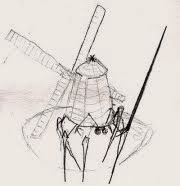Stepper motors seem tidy because they seem controllable. Pulse it once, see the shaft move x degrees. To move any distance, rinse and repeat. However, in a 3d printer, it seems that most of the time - all of the time is being spent on the R & R.
The problem - from a junkyard point of view - is that stepper motors are not as readily available as ordinary motors. And they need a much more complicated interface than a simple H-bridge or relay.
For a sophisticated mechanism, this is not a big problem. Steppers can be bought online with almost any combination of resolution and power. Stepper control circuit designs and boards are also widely available.
But the point of RepStrapping is to build a 3d printer out of ordianry and simple components.
So why not have a mechanism with a continuous motor that scans the entire print area, and just fire material at the right spots? Slaving the X and Y axes together would produce a slightly slanted scan pattern, but probably not enough to be significant. But slaving X Y and Z together would produce a nasty tilt. Unless of course, the frame was pre-tilted to accommodate the slant.
The biggest difference would be the need for accurate position measurements. With a stepper, you can be lazy and count steps from a starting position. The position's value will drift of course, but only by a small amount, and probably comparably along each scan line.
It seems to me that rather than screwing around with the usual poistion sensors, we should just take a look at the optical mouse. Mount a mouse in a poistion where it can scan a rail as the head moves. The mouse I use now cost $14.95 and claims a 2000 dots per inch sensativity.
being a USB device, to does not require any seperate interface to be used with the host PC, either.
This would also mean that the gcode would have to be compiled into a 'bitmap' format.
Labels:
3d printer,
optical mouse sensor,
repstrap
Subscribe to:
Post Comments (Atom)


No comments:
Post a Comment